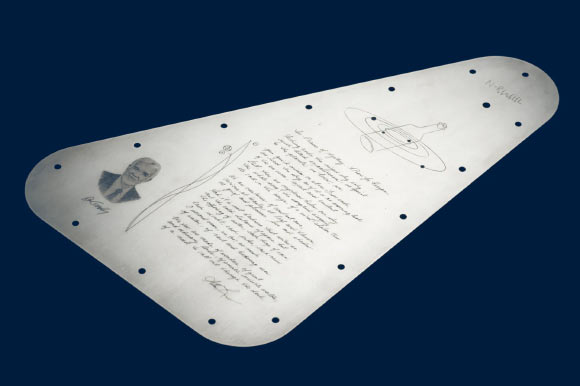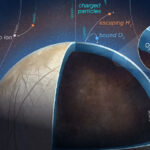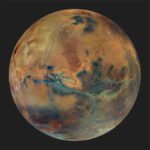NASA’s Europa Clipper spacecraft will carry a triangular metal plate with a special message when it launches in October 2024 and heads toward Jupiter’s moon Europa.
This side of a commemorative plate mounted on NASA’s Europa Clipper spacecraft features U.S. Poet Laureate Ada Limón’s handwritten In Praise of Mystery: A Poem for Europa. Image credit: NASA / JPL-Caltech.
Made of the metal tantalum and about 18 by 28 cm (7 by 11 inches), Europa Clipper’s metal plate features graphic elements on both sides.
At its heart is an engraving of U.S. Poet Laureate Ada Limón’s handwritten In Praise of Mystery: A Poem for Europa, along with a silicon microchip stenciled with more than 2.6 million names submitted by the public.
The microchip will be the centerpiece of an illustration of a bottle amid the Jovian system — a reference to NASA’s Message in a Bottle campaign.
The outward-facing panel features art that highlights Earth’s connection to Europa.
Linguists collected recordings of the word ‘water’ spoken in 103 languages, from families of languages around the world.
The audio files were converted into waveforms (visual representations of sound waves) and etched into the plate.
The waveforms radiate out from a symbol representing the American Sign Language sign for ‘water.’
In the spirit of the Voyager spacecraft’s Golden Record, which carries sounds and images to convey the richness and diversity of life on Earth, the layered message on Europa Clipper aims to spark the imagination and offer a unifying vision.
“The content and design of Europa Clipper’s vault plate are swimming with meaning,” said Dr. Lori Glaze, director of the Planetary Science Division at NASA Headquarters.
“The plate combines the best humanity has to offer across the Universe — science, technology, education, art, and math.”
“The message of connection through water, essential for all forms of life as we know it, perfectly illustrates Earth’s tie to this mysterious ocean world we are setting out to explore.”
In 2030, after a 2.6-billion-km (1.6-billion-mile) journey, Europa Clipper will begin orbiting Jupiter, making 49 close flybys of Europa.
To determine if there are conditions that could support life, the spacecraft’s powerful suite of science instruments will gather data about the moon’s subsurface ocean, icy crust, thin atmosphere, and space environment.
The electronics for those instruments are housed in a massive metal vault designed to protect them from Jupiter’s punishing radiation. The commemorative plate will seal an opening in the vault.
Because searching for habitable conditions is central to the mission, the Drake Equation is etched onto the plate as well — on the inward-facing side.
Astronomer Frank Drake developed the mathematical formulation in 1961 to estimate the possibility of finding advanced civilizations beyond Earth.
The equation has inspired and guided research in astrobiology and related fields ever since.
In addition, artwork on the inward-facing side of the plate will include a reference to the radio frequencies considered plausible for interstellar communication, symbolizing how humanity uses this radio band to listen for messages from the cosmos.
These particular frequencies match the radio waves emitted in space by the components of water and are known by astronomers as the ‘water hole.’ On the plate, they are depicted as radio emission lines.
Finally, the plate includes a portrait of one of the founders of planetary science, Ron Greeley, whose early efforts to develop a Europa mission two decades ago laid the foundation for Europa Clipper.
“We’ve packed a lot of thought and inspiration into this plate design, as we have into this mission itself,” said Europa Clipper project scientist Robert Pappalardo, a researcher at NASA’s Jet Propulsion Laboratory.
“It’s been a decades-long journey, and we can’t wait to see what Europa Clipper shows us at this water world.”




